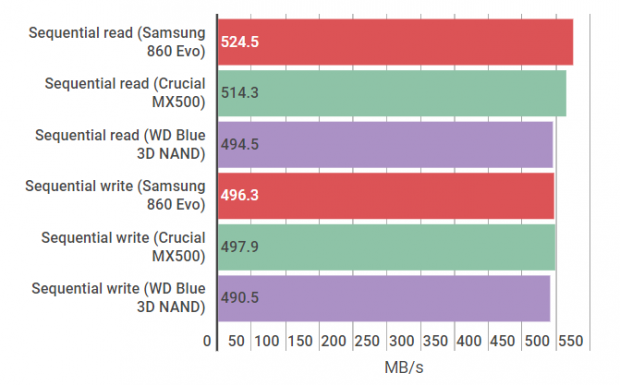
When Western Digital first launched its Blue line of SSDs, it’s in all probability truthful to say that they didn’t actually make a lot of an impression. Not within the face of the mighty Samsung 850 Evo, at the very least, which nonetheless tops a number of Best SSD lists even in the present day. Now, fortunately, WD’s lastly jumped on the 3D NAND bandwagon, making its newest Blue 3D NAND SSDs far more aggressive. There’s nonetheless some approach to go earlier than they attain the identical dizzying heights as Samsung’s new 860 Evo, however the important thing factor is that they’re a lot cheaper, probably making them higher buys for anybody seeking to preserve prices down.
It’s additionally one and the identical as SanDisk’s Ultra 3D SSD, providing you with much more shopping for choices as costs proceed to fluctuate. WD acquired SanDisk in mid 2016, however determined to maintain each manufacturers going for the sake of their respective markets, with WD at all times having been higher on the businessy aspect and SanDisk being bezzie mates with most people. With each SSDs available on-line, nevertheless, the one factor you should fear about is how a lot they each price.
Right now, that’s the WD Blue 3D NAND, and with claimed sequential learn and write speeds of as much as 550MB/s learn and 525MB/s write, it may probably be even higher than the 860 Evo. Let’s learn how it fares in apply.
Today, I’ve obtained the 250GB 2.5in WD Blue 3D NAND in for testing, however you may also discover it in 500GB, 1TB and 2TB capacities in each 2.5in and NVMe type components (with the 2TB NVMe mannequin being a very tempting finances different to the ludicrously costly Samsung 960 Pro).
At the second, the WD Blue 3D NAND is sort of a bit cheaper than the 860 Evo, with the 250GB 2.5in model beginning round £75 / $80 versus £89 / $95. It does, nevertheless, include just a few caveats.
Firstly, its assure solely extends to a few years moderately than the 5, and its endurance score solely ranges between 100 terabytes written (TBW) for the bottom 250GB mannequin as much as 500 TBW for the 2TB model. The 860 Evo, by comparability, provides between 150 TBW and 2400 TBW. For some, that alone shall be sufficient to tempt them away from the Blue 3D NAND, however for these seeking to preserve prices as little as doable, WD’s drive nonetheless places in a fairly good efficiency.

Using my three.6GHz Intel Core i5-8600Ok processor, 16GB of Corsair Vengeance 3000MHz RAM and Asus Prime Z370-P motherboard take a look at rig, I began my testing with AS SSD’s 1GB sequential take a look at, which reads and writes information in adjoining areas on an SSD’s storage blocks. Here, the Blue 3D NAND managed a powerful 494.5MB/s learn and 490.5MB/s write. That’s not fairly as fast because the 860 Evo, however the distinction is fairly minimal. Indeed, the Blue 3D NAND’s learn pace was simply three% slower, whereas its write pace was simply 1% slower.
Sequential speeds aren’t actually the very best indicator of an SSD’s real-life efficiency, nevertheless, as information hardly ever will get saved in such a neat, orderly vogue. Instead, information’s typically dumped everywhere in tiny chunks, and it’s right here the place the Blue 3D NAND begins to lag behind.
In AS SSD’s 1GB random 4K take a look at, as an example, WD’s drive managed simply 29.5MB/s learn and 56.6MB/s write. That’s 27% and 42% slower than the 860 Evo, which is sort of a drop contemplating the 860 Evo prices simply £14 / $15 extra at 250GB.
When you take a look at the ever widening value hole additional up the capability chain, nevertheless – £36 / $35 at 500GB, £57 / $30 at 1TB and £96 / $127 at 2TB – that lower in pace instantly begins to look much more palatable.


The predominant downside is the Crucial MX500, which is even cheaper than the Blue 3D NAND within the UK (and exactly the same price within the US), and nonetheless fairly a bit higher at coping with small random information, producing learn and write speeds that had been 19% and 22% sooner respectively than WD’s drive beneath the identical circumstances.
That stated, the Blue 3D NAND was fairly near each drives once I put it by CrystalDiskMark’s taxing random 4K Eight-queue-Eight-thread take a look at, which places it by a a lot heavier workload not in contrast to what you’d sometimes see on a server or workstation. Here, the Blue 3D NAND carried out admirably, producing a learn pace of 400.7MB/s and a write pace of 346.1MB/s. The former was bang in the midst of Samsung and Crucial’s efforts, whereas its write pace was simply 6% slower than the MX500 and three% slower than the 860 Evo.
As a end result, the WD Blue 3D NAND (and by extension the SanDisk Ultra 3D) continues to be a wonderful choose for PCs usually coping with bigger workloads, however for the remainder of us, you may as save your self a bit of money and get the Crucial MX500 as a substitute. It may not be as quick because the Samsung 860 Evo, however it’s arguably a lot better worth for cash, particularly when you begin trying past the essential 250GB mannequin.


